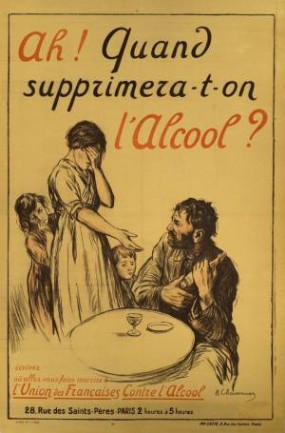
 Poster created by L'Union des Françaises contre l'alcool (drawing by David Burnand), 1917.
Poster created by L'Union des Françaises contre l'alcool (drawing by David Burnand), 1917.
In the 1810s, the first temperance societies were established in the United States. Their goal is to divert Americans from alcoholic beverages, by making them sign oaths of abstinence. A few years later, the idea crossed the Atlantic to land in England — the shared language and beliefs facilitated its assimilation; At the same time, explorers' trips, the deployment of the telegraph and the development of the press contribute to the dissemination of news throughout the world. Other nations were interested in the problem of excessive consumption of alcoholic beverages, including France: in June 1835, the Royal Court councillor of Amiens, Henri Dutrône, announced the creation of the society of sobriety. However, apart from the American and British movements, which rapidly displayed hundreds of thousands of supporters, other initiatives were sporadic and ephemeral. This did not prevent the organization of the Universal Temperance Convention in 1846 with only three countries: the United States, Great Britain and Canada.
The scientific description of alcoholism by Magnus Huss, in 1849, the multiplication of temperance societies in several countries and the formation of first associations with transnational aspirations (the International Organisation of Good Templars and the Woman’s Christian Temperance Union) mark the second stage of development of the antialcoholism. The French Temperance Society (SFT) is part of the growth logic of the movement. Formed in 1872 mainly by doctors and elite men, following the denunciation of alcoholism as a cause in the defeat of France in the Franco-Prussian war and the debauches of the Commune, the SFT becomes the national association of reference. Its members are asked by transnational associations to establish long-term contacts and collaborations, but mergers do not take place.
From the 1880s until the First World War, the transnational temperance movement was at its peak. World anti-alcoholic congresses are held regularly under the auspices of the International Temperance Council, which was established in 1907. Although the challenges of a universal alcohol control strategy are regularly discussed, Council member countries are more concerned about regulations at the national level. Moreover, certain movements are developing and becoming more complex to the point that various groupings no longer find agreement, as in the United States, England or Switzerland.
In France, among the associations that multiplied in the 1890s, is the Union Française Antialcoolique (French anti-alcoholic Union), created by Dr Paul-Maurice Legrain. The Union became the centre of the French movement. But the inflexible and impenitent character of its founder prevents it from realizing its greatest ambition: to gather all associations under its banners. This missed opportunity provokes a real «schism» in the movement, and the associations do not stop to compete for the stakes of their battle: should we militate for the abstinence of all alcoholic beverages? Advocating moderation? How to reach the government? Educating the public?
After the First World War, antialcoholism continued, but some researchers pointed to its weakening, even decline. We are seeing more of the new withdrawal of militants from their countries following the entry of the public authorities. A wave of prohibition obliges the movements — until then essentially private — to reinvent themselves: it destroys some and forces others to seek new objects of combat.
Thus, in the second half of the 20th century, the fight against alcoholism shifted towards the fight against addictions and embraced other public issues such as road safety or consumption among young people. The International Temperance Council is modernizing itself and includes the fight against addictions in its objectives. As for transnational antialcoholism, the World Health Organization manages this component and regularly reiterates its recommendations regarding the “global strategy to reduce the harmful use of alcohol”. The latest recommendations were published in 2010.
The French anti-alcoholic movement followed its path: after a brief intervention by the public authorities during the Great War, few major transformations occurred for private associations. The State did not intervene there until the 1950s, with the «State anti-alcoholism» of the Pierre Mendès-France government and the creation of the first specialized public body (the High Committee of Studies and Information on Alcoholism). Today, the French anti-alcoholic movement has almost faded in the face of the development of the fight against addictions.
Read more in the dictionary : Patient associations
Read the paper in French : Antialcoolisme
References :
Didier Nourrisson, Alcoolisme et antialcoolisme en France sous la Troisième République : l’exemple de la Seine Inférieure, La Documentation française, 1988.
Mark Lawrence Schrad, The Political Power of Bad Ideas: Networks, Institutions, and the Global Prohibition Wave, Oxford University Press, 2010.
To quote this paper : Victoria Afanasyeva, "Antialcoholism" in Hervé Guillemain (dir.), DicoPolHiS, Le Mans Université, 2021.